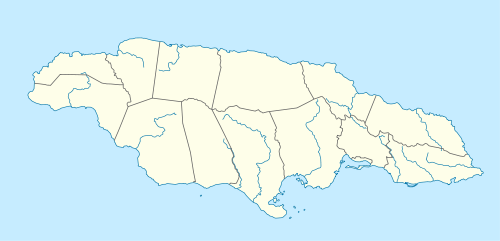Accompong
Coordinates: 18°14′N 77°45′W / 18.233°N 77.750°W
| Accompong | |
|---|---|
|
Accompong, Jamaica, early 20th century | |
| Nickname(s): Acheampong | |
 Accompong | |
| Coordinates: 18°14′N 77°45′W / 18.233°N 77.750°W | |
| Country |
|
| Parish | St. Elizabeth Parish |
Accompong (from the Akan name Acheampong) is a historical Maroon village located in the hills of St. Elizabeth Parish on the Island of Jamaica. It is located in Cockpit Country, where the local terrain enabled Maroons and indigenous Taíno to establish a fortified stronghold in the 17th century. They defended it to maintain independence from the Spanish and then later against British forces, after the colony changed hands.
The people named their community Accompong after an early Maroon leader. Their autonomy with certain rights for limited self government was established by a peace treaty with the British in 1739.[1] Since independence in 1962, the government of Jamaica has continued to recognize Maroon indigenous rights in this area.
History
In the 18th century, Maroon leader Cudjoe[2] is said to have united his people under the Kindah Tree in their fight for autonomy. This was the site for signing the 1739 treaty with the British. This legendary, ancient mango tree is still standing (2009).[3] The tree symbolizes the common kinship of the community on its common land.[4]

Accompong was founded in 1739 after rebel slaves and their descendants fought a protracted war with the British that was finally settled by a treaty between the two groups. The treaty signed under British governor Edward Trelawny granted Cudjoe’s Maroons 1500 acres of land between their strongholds of Trelawny Town and Accompong in the Cockpits . It also granted a certain amount of political autonomy and economic freedoms for the Maroons, in return for which they were obligated to provide military support in case of invasion or rebellion, and to return runaway slaves in exchange for a bounty of two dollars each. This last clause in the treaty caused tension between the Maroons and the enslaved black population. From time to time refugees from the plantations still found their way into maroon settlements and were allowed to stay.[5]
Government
The community was granted certain rights and autonomy by treaty with the British colonial authorities in 1739. It set up a traditional form of village government drawn from its Akan and Asante culture, based on men recognized as leaders. It has an executive now called "Colonel-in-Chief", who leads the Maroon Council.[6][7] These men who share executive responsibilities for the community.[7]
Since Jamaica gained independence in 1962, it has recognised the political and cultural rights of Maroons. In the early 21st century, the government has acknowledged these rights in terms of the UN Declaration on the Rights of Indigenous Peoples (2007), including the "right to maintain and strengthen their distinct political, legal, economic, social and cultural institutions." It also acknowledges the "right for self-government in matters relating to local affairs," as well as "ways and means for financing autonomous functions.[8]
In 2009 Ferron Williams was elected as Colonel-in-Chief of Accompong.[6][7][9] Ferron was elected to a second term in 2015. He appointed Timothy E. McPherson Jr. from Nanny Town to consolidate relations across the Maroon communities as part of a collective effort to protect the environment and promote climate change awareness.[10][11]
Culture
The inhabitants of Accompong share practices and traditions drawn from the cultures Akan and Asante ancestors of 200–300 years ago, and combined with Taino.[2] These practices have evolved as the Maroons adapted to local conditions.
Descendants of the Maroons and friends celebrate annually on January 6 both the birthday of Cudjoe, leader in 1739, and the treaty which granted their autonomy.[3][12] In 2007, attendees at the festival protested increased bauxite mining, in an effort to protect the environment of their region.[12]
See also
References
- ↑ "Accompong", Jamaica National Heritage Trust.
- 1 2 Wright, M. L. "The Accompong Town Maroons: Past and Present", 1992 Festival of American Folklife catalogue, Center for Folklife and Cultural Heritage of the Smithsonian Institution, 1992.
- 1 2 Myers, Garfield, "Maroons hold 'mother of all celebrations' at 268th annual festival" Archived 2 March 2007 at the Wayback Machine., African Axis, 8 January 2006.
- ↑ Jean Besson, "Folk Law and Legal Pluralism in Jamaica", Journal of Legal Pluralism, No. 43, 1999.
- ↑ Craton, Michael. Testing the Chains. Cornell University Press, 1982, p. 89-90
- 1 2 "Colonel vows to revive flogging for criminal acts - News". Jamaica Observer.
- 1 2 3 "Accompong, the town that is hardly Jamaica". The Guardian. 21 February 2007.
- ↑ Golding, Mark. "The Importance of the Legal recognition of Maroon rights" (PDF). Ministry of Justice. Ministry of Justice, Jamaica. Retrieved 15 September 2015.
- ↑ "Ferron Williams returned as Accompong Maroon colonel - Latest News". Jamaica Observer.
- ↑ https://www.newsghana.com.gh/gcpp-accompong-believe-renewable-energy-is-the-future-for-africa-and-the-caribbean/
- ↑ http://www.jamaicaobserver.com/news/Accompong-Maroons-reaffirm-claim-to-Cockpit-Country_48072
- 1 2 Myers, Garfield, "Maroons unite in defence of Cockpit Country" Archived 10 February 2007 at the Wayback Machine., The Jamaica Observer, 8 January 2007.
.jpg)